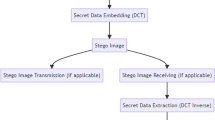Abstract
Hiding a secret message in a cover image with the least possible statistical detectability is the objective of steganography. This is generally formulated as a problem of minimal-distortion embedding and practically implemented by incorporating an efficient coding method and a well-designed distortion metric. In this paper, we construct a new distortion metric for JPEG steganography, which employs a local linear predictor to generate both the intra- and inter-block prediction errors of a quantized DCT coefficeint, and then accumulates them to form the distortion metric for this coefficient. Such distortion metric is then further integrated in the minimal-distortion framework using STC to give rise to the proposed JPEG steganographic scheme. This scheme exploits the proposed distortion metric to guide the STC to hide the secret message in those quantized DCT coefficients with minimal distortion cost. Consequently, the average changes of both first- and second-order statistics of quantized DCT coefficients and thus the statistical detectability would decrease significantly. Compared with prior arts, experimental results demonstrate the effectiveness of the proposed scheme in terms of secure embedding capacity against steganalysis.












Similar content being viewed by others
References
Filler T., Judas J. Fridrich J. (2010). Minimizing embedding impact in steganography using Trellis-Coded Quantization, in Proceedings SPIE, Electronic Imaging, Security and Forensics of Multimedia XII, ed. by S Jose, vol. 7541 (CA, 2010), 17–21.
Westfeld, A. (2001). F5 - A steganographic algorithm: high capacity despite better steganalysis. In Proceedings of the 4th International Workshop on Information Hiding, 289–302.
Fridrich, J., Pevny, T., & Kodavsky, J. (2007). Statistically undetectable JPEG steganography: Dead ends, challenges, and opportunities. In Proceedings of the 9th Workshop on Multimedia and Security, 3–14.
Kim, H. Y., Duric, Z., & Rechards, D. (2007). Modified matrix encoding technique for minimal distortion steganography. In Proceedings of the 8th International Workshop on Information Hiding, 314–327.
Choi, Y., & Kim, H. (2009). Improving the modified matrix encoding on steganography Method. In Proceedings of the International Conference on Information Assurance and Security. 205–208.
Sachnev, V., Kim, H.-J., & Zhang, R. (2009). Less detectable JPEG steganography method based on heuristic optimization and BCH syndrome coding. In Proceedings of the 11th ACM Workshop on Multimedia and Security. 131–139.
Solanki, K., Sarkar, A., & Manjunath, B. S. (2008). YASS: yet another steganographic scheme that resists blind steganalysis. In T. Furon, F. Cayre, G. Doërr, & P. Bas (Eds.), IH 2007. LNCS (Vol. 4567, pp. 16–31). Heidelberg: Springer.
Yu, L. F., Zhao, Y., Ni, R. R., & Cao, G. (2014). A New Channel Selection Rule for YASS. Science China Information Sciences, 2014(8), 156–165.
Filler T., Fridrich J. (2011). Design of adaptive steganographic schemes for digital images, in Proc. SPIE, Electronic Imaging, Media Watermarking, Security, and Forensics XIII, San Francisco, USA, 23–27 January 2011.
Kodovsky J., Fridrich J.(2009) Calibration revisited, in Proceedings of the 11th ACM Multimedia and Security Workshop, Princeton, USA, 7–8 September 2009.
Pevny T., Fridrich J.(2007), Merging Markov and DCT features for multiclass JPEG steganalysis, in Proc. SPIE, Electronic Imaging, Security, Steganography, and Watermarking of Multimedia Contents IX. Ed. by S Jose, vol.6505, (CA, 2007), 301–314.
Kodovsk’y J., Fridrich J., Holub V. (2011). On dangers of overtraining steganography to incomplete cover model, in Proceedings of the 13th ACM Multimedia& Security Workshop, Niagara Falls, NY, 29–30 September 2011, 69–76.
Holub V. & Fridrich J. (2013). Digital image steganography using universal distortion, in Proceedings of the first ACM workshop on Information hiding and multimedia security, 2013, 59–68.
Pevny, T., & Fridrich, J. (2007). Merging markov and DCT features for multi-class JPEG steganalysis. In Proceedings of the SPIE Conference on Security, Steganography and Watermarking of Multimedia Contents IX
Chen C, Shi Y. Q. (2008). JPEG image steganalysis utilizing both intrablock and interblock correlations, IEEE ISCAS, International Symposium on Circuits and Systems. 3029–3032.
Kodovsky J., Fridrich J. (2012). Steganalysis of JPEG Images Using Rich Models, in Proc. SPIE, Electronic Imaging, Media Watermarking, Security and Forensics XIV, San Francisco, USA, 23–25 January 2012
Narwaria, M., Lin, W., McLoughlin, I., Emmanuel, S., & Tien, C. (2012). Fourier Transform Based Scalable Image Quality Measure. IEEE Transactions on Image Processing, 21(8), 3364–3377.
] Shan Q., Jia J., & Agarwala A. (2008). High-Quality Motion Deblurring From a Single Image, ACM Transactions on Graphics (SIGGRAPH 2008), 27(3)
Bas P., Filler T., & Pevn’y T. (2011). Break our steganographic system —the ins and outs of organizing boss, in Proc. 13th Information Hiding Conf., 59–70, http://www.agents.cz/boss/.
Kodovsky J., Fridrich J., & Holub V. (2012). Ensemble Classifiers for Steganalysis of Digital Media, IEEE Transactions on Information Forensics and Security, 7(2), 432–444, Soft-ware available at http://dde.binghamton.edu/download/nsf5simulator/.
Chang C. C., Lin C. J. (2001). LIBSVM: a library for support vector machines,, http://www.csie.ntu.edu.tw/cjlin/libsvm/.
Acknowledgments
This work is supported by National Natural Science Foundation of China (No. 61379156 and 61202467), the National Research Foundation for the Doctoral Program of Higher Education of China (No. 20120171110037), the Key Program of Natural Science Foundation of Guangdong (No. S2012020011114), and the Scientific Research Foundation for Returned Overseas Chinese Scholars, State Education Ministry.
Author information
Authors and Affiliations
Corresponding author
Rights and permissions
About this article
Cite this article
Wang, C., Ni, J. & Wang, C. New Distortion Metric for Efficient JPEG Steganography Using Linear Prediction. J Sign Process Syst 81, 389–400 (2015). https://doi.org/10.1007/s11265-014-0961-5
Received:
Revised:
Accepted:
Published:
Issue Date:
DOI: https://doi.org/10.1007/s11265-014-0961-5




